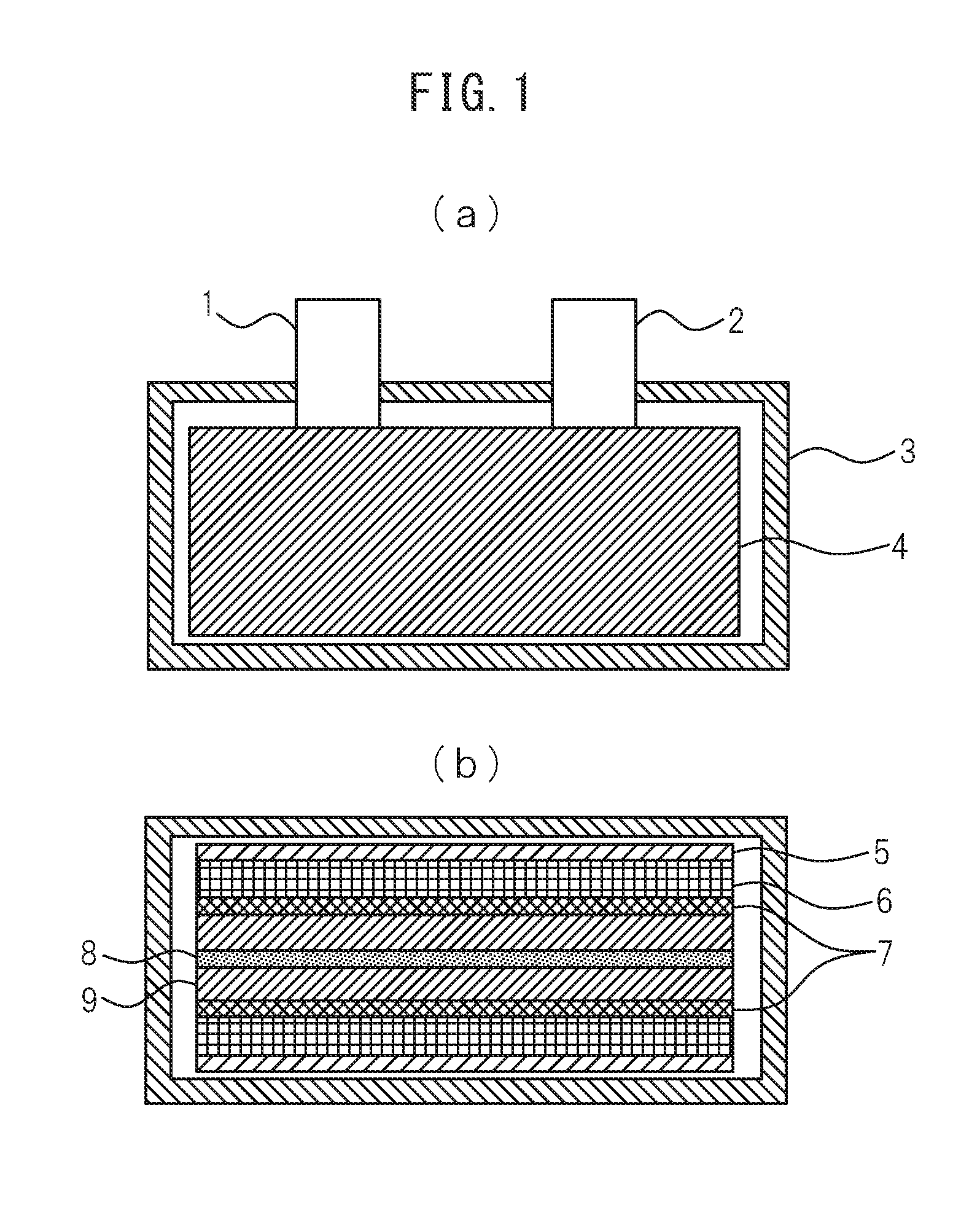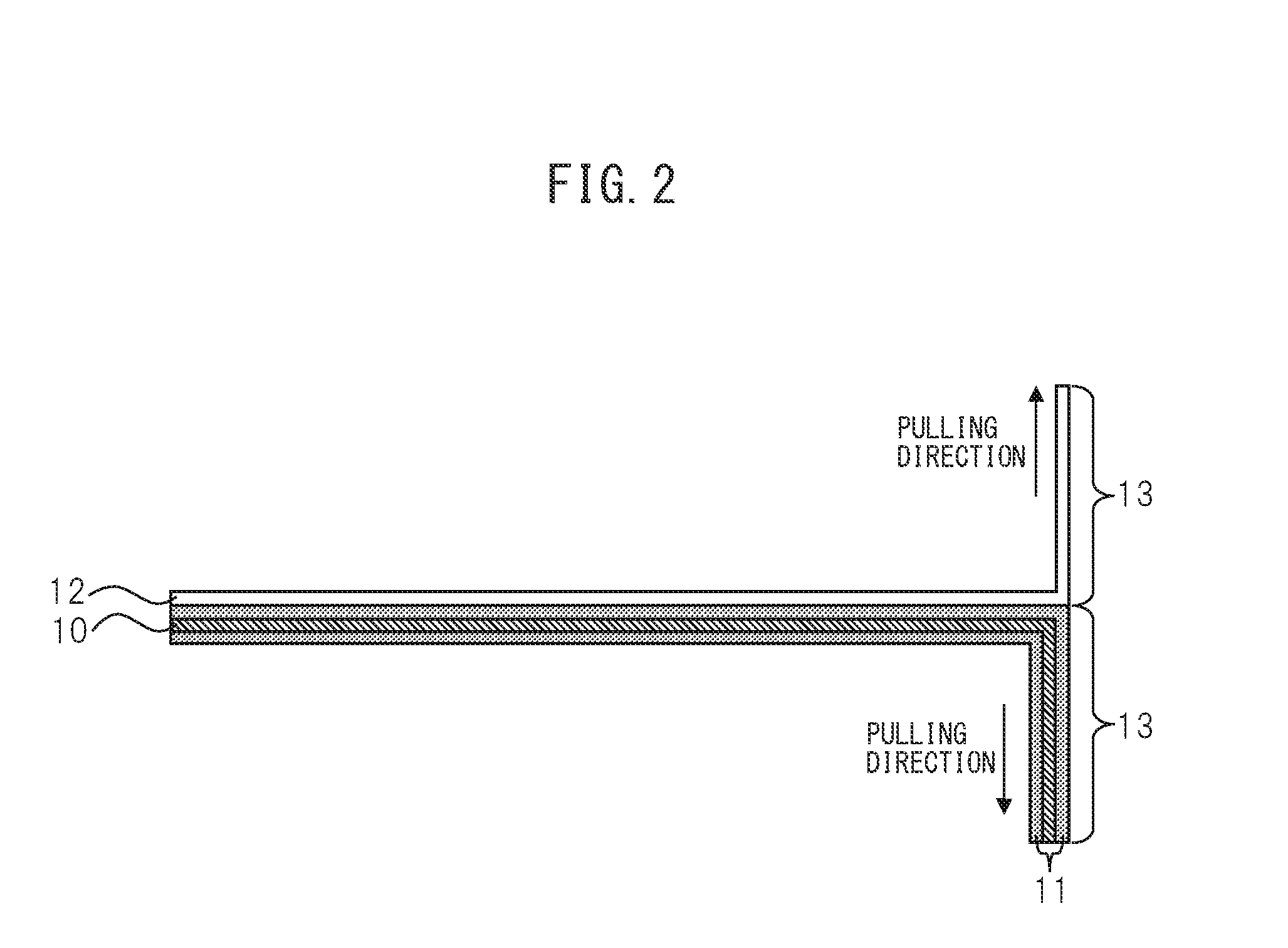Lithium Ion Capacitor
a technology of lithium ion capacitors and capacitors, applied in the direction of electrolytic capacitors, capacitors, transportation and packaging, etc., can solve the problems of poor input/output characteristics, poor cycle characteristics, poor durability, etc., and achieve high output characteristics and high energy density, high-rate cycle durability, and high energy density
- Summary
- Abstract
- Description
- Claims
- Application Information
AI Technical Summary
Benefits of technology
Problems solved by technology
Method used
Image
Examples
preparation example 1
[0164]A kneaded mixture, obtained by kneading 100 parts by weight of carbon black (CB1) with a mean particle size of 30 nm and a BET specific surface area of 254 m2 / g and 50 parts by weight of optically isotropic pitch (P1) with a softening point of 110° C. and a mesophase quantity (QI quantity) of 13%, with a heated kneader, was baked in a non-oxidizing atmosphere at 1,000° C. This was pulverized to a mean particle size (D50) of 2 μm to obtain composite carbon material 1. The mean particle size of the composite carbon material 1 was measured using an MT-3300EX by Nikkiso Co., Ltd.
[0165]The absorption isotherm of composite carbon material 1 with nitrogen as the adsorbate was measured using a pore distribution measuring apparatus (AUTOSORB-1 AS-1-MP) by Yuasa-Ionics, Inc., with nitrogen as the adsorbate. The BET specific surface area determined by the single point BET method was 110 m2 / g.
preparation examples 2 to 13
[0166]A composite carbon material was prepared in the same manner as Example 1, except that in the of Preparation Example 1, the types and amounts of carbon black and pitch used, and the mean particle sizes after pulverizing, were as listed in Table 1.
[Table 1]
[0167]
TABLE 1Preparation of composite carbon materialsMean BETStarting materialparticlespecific Carbon blackPitchsizesurfaceAmountAmount(D50)areaNameType(pts by wt)Type(pts by wt)(μm)(m2 / g)Prep. Ex. 1Composite carbon material 1CB1100P1502110Prep. Ex. 2Composite carbon material 2CB2100P11002240Prep. Ex. 3Composite carbon material 3CB2100P1302330Prep. Ex. 4Composite carbon material 4CB1100P1302123Prep. Ex. 5Composite carbon material 5CB2100P11502180Prep. Ex. 6Composite carbon material 6CB2100P1102600Prep. Ex. 7Composite carbon material 7CB3100P1133224Prep. Ex. 8Composite carbon material 8CB2100P11005286Prep. Ex. 9Composite carbon material 9CB2100P110010283Prep. Ex. 10Composite carbon material 10CB2100P110015279Prep. Ex. 11Compo...
example 1
Fabrication of Negative Electrode
[0173]A slurry with a solid concentration of 18 mass % was obtained by mixing 80.0 parts by mass of the composite carbon material 1 obtained in Preparation Example 1, 8.0 parts by mass of acetylene black, 3.0 parts by mass of CMC (carboxymethyl cellulose), 9.0 parts by mass of SBR latex, and distilled water. The obtained slurry was then coated and dried onto both sides of etching copper foil with a thickness of 15 μm, and pressed to obtain a negative electrode. The thickness per side of the negative electrode active material layers of the obtained negative electrode was 20 μm. The thickness of the negative electrode active material layer was determined as the value of subtracting the thickness of the copper foil from the average thickness of the negative electrode measured at 10 points of the negative electrode using a (Linear Gauge Sensor GS-551) by Ono Sokki Co., Ltd.
[Pre-Doping]
[0174]The obtained negative electrode was cut to 3 cm2 to form a worki...
PUM
 Login to View More
Login to View More Abstract
Description
Claims
Application Information
 Login to View More
Login to View More - R&D
- Intellectual Property
- Life Sciences
- Materials
- Tech Scout
- Unparalleled Data Quality
- Higher Quality Content
- 60% Fewer Hallucinations
Browse by: Latest US Patents, China's latest patents, Technical Efficacy Thesaurus, Application Domain, Technology Topic, Popular Technical Reports.
© 2025 PatSnap. All rights reserved.Legal|Privacy policy|Modern Slavery Act Transparency Statement|Sitemap|About US| Contact US: help@patsnap.com



